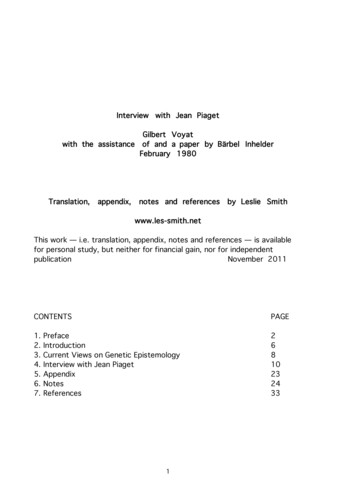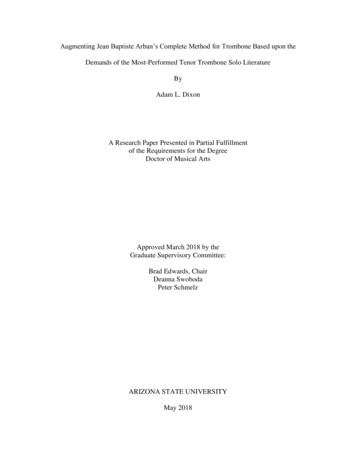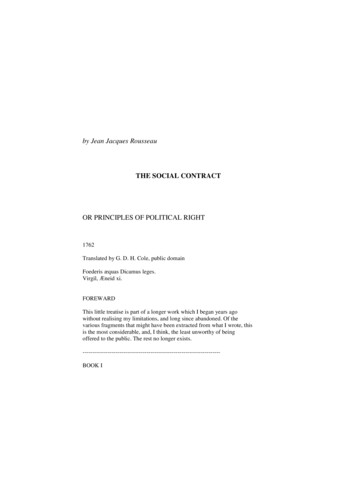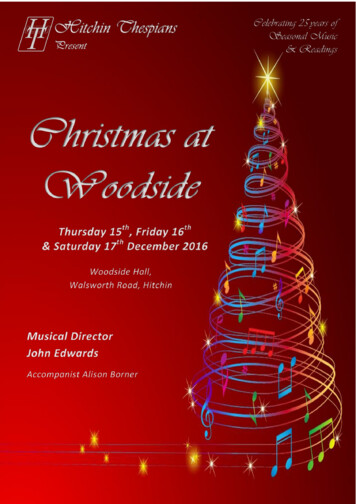
Transcription
JEAN-MICHEL DEFAYE’S Á LA MANIÉRE DE DEBUSSY POUR TROMBONE ETPIANO: A COMPOSITIONAL COMPARISON TO CLAUDE DEBUSSY’SHARMONIC, MELODIC, AND RHYTHMIC PRACTICESAaron Christian Rader, B.M., M.M.Dissertation Prepared for the Degree ofDOCTOR OF MUSICAL ARTSUNIVERSITY OF NORTH TEXASDecember 2011APPROVED:Vern Kagarice, Major ProfessorSteve Wiest, Minor ProfessorTony Baker, Committee MemberJohn Holt, Chair of the Division ofInstrumental StudiesLynn Eustis, Director of GraduateStudies in the College of MusicJames D. Meernik, Acting Dean of theToulouse Graduate School
Rader, Aaron Christian. Jean-Michel Defaye’s Á La Maniére de Debussy pourTrombone et Piano: A Compositional Comparison to Claude Debussy’s Harmonic,Melodic, and Rhythmic Practices. Doctor of Musical Arts (Performance), December2011, 40 pp., 30 examples, references, 34 titles.Jean-Michel Defaye composed Á La Maniére de Debussy in 2001 as part of aseries of trombone solos written to emulate the compositional styles of significantpredecessors. This study compares Á La Maniére de Debussy to the harmonic,melodic, and rhythmic practices of Claude Debussy (1862–1918), an innovative Frenchcomposer and recognized figure of musical Impressionism. At present, there is limitedscholarship on Defaye’s Á La Maniére de Debussy and its compositionally imitativenature.The first section of this document presents a survey of historical information,current literature, and methods of examination. The second section providesbiographical information on composers Jean-Michel Defaye and Claude Debussy. Thethird section exhibits a compositional comparison of Á La Maniére de Debussy toDebussy’s use of harmony, melody, and rhythm. The final section draws a conclusionto the piece’s importance to the trombone solo repertoire and includes an interview withFrench trombonist Jacques Mauger who collaborated with Defaye on Á La Maniére deDebussy.Although this document is not a performance guide, an informed performance ofÁ La Maniére de Debussy requires a trombonist to understand Debussy’s uniquetreatment of harmony, melody, and rhythm.
Copyright 2011byAaron Christian Raderii
ACKNOWLEDGEMENTSI would like to thank Vern Kagarice, Tony Baker, and Steve Wiest for serving asmembers of my doctoral committee. Your guidance through this project has beendeeply appreciated.Vern Kagarice encouraged me to perform Defaye’s Á La Maniére de Debussyalmost five years ago, and it quickly became one of my favorite pieces for trombone andpiano. I had never envisioned this document being the result.Jacques Mauger greatly broadened my research by speaking to me about JeanMichel Defaye and Á La Maniére de Debussy. I hope to share his thoughts andsentiments with as many trombonists as possible.Etienne Stoupy translated my electronic interview with Jacques Mauger, and healso provided first-hand knowledge of his native France.Nataliya Sukhina accompanied me during my lecture recital and made theperformance of a great piece even more enjoyable.My parents John and Carol Rader have encouraged my musical aspirationsthroughout the years, and I am forever grateful of their unconditional love andinspiration.To my wife Erin Rader, thank you for unknowingly giving me the motivation tofinish my doctoral degree. Your faith in my potential is truly a gift.All images in this document are reproduced under Public Domain or Fair UseProvisions.iii
TABLE OF CONTENTSPageACKNOWLEDGEMENTS . iiiLIST OF TABLES . viLIST OF EXAMPLES . viiINTRODUCTION . 1Survey of Historical Information . 1Current Literature . 3Methods of Examination . 6COMPOSER BIOGRAPHY . 7Jean-Michel Defaye . 7Achille-Claude Debussy . 8HARMONIC COMPARISON . 11Non-Functional Pedal Point . 11Parallel Chord Succession. 15Extended Tertian Chord Tones. 19MELODIC COMPARISON . 23Medieval Church Modes . 23Pentatonic . 26Whole-Tone . 29RHYTHMIC COMPARISON . 31Horizontal Polyrhythms . 31Tempo Fluctuation . 33iv
CONCLUSIONS . 36Importance to Trombone Solo Repertoire . 36BIBLIOGRAPHY . 38v
LIST OF TABLESPage1. Extensions in trombone part – Defaye, Á La Maniére de Debussy . 222. Tempo Fluctuation – Debussy, Arabesque No. 1 . 343. Tempo Fluctuation – Defaye, Á La Maniére de Debussy . 35vi
LIST OF EXAMPLESPage1. Monet, Impression – Sunrise . 22. Pedal Point – Defaye, Á La Maniére de Debussy, mm. 20–25. 123. Pedal Point – Defaye, Á La Maniére de Debussy, mm. 45–49. 124. Pedal Point – Defaye, Á La Maniére de Debussy, mm. 56–61. 135. Pedal Point – Debussy, La Cathedrale Engloutie, mm. 28–41 . 146. Pedal Point – Debussy, La Cathedrale Engloutie, mm. 72–77 . 157. Fauxbourdon – Binchois, Da Pacem Domine, line 3 . 158. Parallel Succession – Defaye, Á La Maniére de Debussy, mm. 29–30 . 169. Parallel Succession – Defaye, Á La Maniére de Debussy, m. 40 . 1610. Parallel Succession – Defaye, Á La Maniére de Debussy, mm. 50–56 . 1711. Parallel Succession – Debussy, Girl with the Flaxen Hair, mm. 33–35 . 1812. Parallel Succession – Debussy, La Cathedrale Engloutie, mm. 62–67 . 1913. 16 Partials of the Overtone Series. 2014. Extensions – Defaye, Á La Maniére de Debussy, m. 1 . 2115. The Medieval Church Modes . 2416. Church Modes – Defaye, Á La Maniére de Debussy, mm. 20–28 . 2517. Church Modes – Defaye, Á La Maniére de Debussy, mm. 35–49 . 2518. Church Modes – Defaye, Á La Maniére de Debussy, mm. 56–63 . 2619. Pentatonic Scale compared to Major Scale . 2620. Pentatonic – Defaye, Á La Maniére de Debussy, mm. 1–5 . 2721. Pentatonic – Debussy, Printemps, mm. 1–5 . 2722. Pentatonic – Debussy, Arabesque No. 1, mm. 6–9 . 28vii
23. Pentatonic – Debussy, Girl with the Flaxen Hair, mm. 1–7 . 2824. Whole-Tone – Defaye, Á La Maniére de Debussy, mm. 50–56 . 2925. Whole-Tone – Debussy, Beau Soir, mm. 9–11 . 3026. Whole-Tone – Debussy, Clair de Lune, mm. 29–30 . 3027. Rhythmic Outline – Guiraud, Cavatine de Marthe, mm. 55–58 . 3228. Horizontal Polyrhythms – Defaye, Á La Maniére de Debussy, mm. 12–13 . 3229. Horizontal Polyrhythms – Defaye, Á La Maniére de Debussy, mm. 71–75 . 3230. Horizontal Polyrhythms – Debussy, Clair de Lune, mm. 1–4 . 33viii
INTRODUCTIONSurvey of Historical InformationJean-Michel Defaye (b. 1932) has been an active composer in France for morethan 60 years. He studied musical composition with Darius Milhaud and Tony Aubin atthe Conservatoire National Supérior de Musique de Paris, graduating in 1953.1 Whiletrombonists widely know of Deux Danses for trombone and piano (1953), Defaye hascontinued to compose solo repertoire for the instrument. In 1990, he released the firstpiece in a series of trombone solos based on the compositional styles of significantpredecessors. Each title begins with Á La Maniére de, which translates to In theManner of:Á La Maniére de Bach (1990)Á La Maniére de Schumann (2000)Á La Maniére de Debussy (2001)Á La Maniére de Vivaldi (2002)Á La Maniére de Stravinsky (2005)Á La Maniére de Brahms (2011)This document focuses on Á La Maniére de Debussy (In the Manner ofDebussy). Although the piece was written in the 21st century, it assimilates theharmonic, melodic, and rhythmic practices of Claude Debussy (1862–1918), aninnovative French composer and recognized leader of musical Impressionism.In an attempt to define “Impressionism” in musical terms, one must understandthe origins of such a classification. The term was first applied to the realm of paintedart. In 1874, Parisian art critic Jules Antoine Castagnary wrote an article in thenewspaper Le Siécle concerning an innovative group of French artists whom he1Flanigan, Sean Gerald. From Deux Danses to Fluctuations: Compositional Components and Innovationsin Two Solo Trombone Works of Jean-Michel Defaye. Diss. University of North Texas, August 2006, 3.1
characterized as “Impressionists” based on painter Claude Monet’s Impression –Sunrise (1872).2 Monet’s harbor scene, as seen through the early morning mist,Example 1. Monet, Impression – Sunriselacked definite boundaries and had the effect of “merging sky and water imperceptiblyinto the other.”3 The Impressionist technique of artistry created an almost movingaesthetic of light and color. Above all, Impressionism in art was concerned withsensation, rather than the absolute rendering of an object or landscape.4 Claude Monetpainted an image not as it stood in reality, but as an individual perceived it in thesurrounding atmosphere.5Claude Debussy took influence from Impressionistic artists and applied it tomusic. In 1887, members of the Académie des Beaux-Arts issued a report about thecomposer’s orchestral piece Printemps, saying, “His feeling for musical color is so2Byrnside, Ronald. “Musical Impressionism: The Early History of the Term,” The Musical Quarterly, Vol.66, No. 4 (October 1980), 522.3Palmer, Christopher. Impressionism in Music. New York: Charles Scribner’s Sons, 1974, 14.4Pasler, Jann. “Impressionism.” Oxford Music Online. Web. 1 Mar 2010.5Palmer, 13.2
strong that he is apt to forget the importance of accuracy of line and form. He shouldbeware this vague impressionism which is one of the most dangerous enemies ofartistic truth.”6 Regarding Impressionistic art, the importance of color surpassed that ofdesign, clarity, and clear-cut forms.7 This lack of definition appealed to Debussy, whosemusical ambition was to focus on sensation over form, auditory pleasure beforeacademic law.8Current LiteratureSince the initial publication of Á La Maniére de Debussy in 2001, few havewritten about the piece and its compositionally imitative nature.In October 2003, Wayne Groves included a literature review of Á La Maniére deDebussy in the International Trombone Association (ITA) Journal.9 He described thetrombone solo as being similar to Deux Danses with its “beautiful melodic material” andmentioned Defaye’s inclusion of “pentatonic material as well as 9th, 11th, and 13th chordsthat are usually associated with the style of Debussy.”10 The literature review closeswith a brief discussion of range, clefs, mutes (none), and difficulty of the pianoaccompaniment.11In 2009, trombonist and college professor Brent Phillips released a recording of ÁLa Maniére de Debussy on his album “Stepping Stones for Trombone, Volume 1.”12 Inthe liner notes, Phillips mentioned how the piece “mimics the compositional style of6Byrnside, “Musical Impressionism: The Early History of the Term,” 523.Mueller, Robert. The Concept of Tonality in Impressionist Music: Based on the Works of Debussy andRavel. Diss. Indiana University, August 1954, 5.8Palmer, 22.9Groves, Wayne. “Literature Reviews,” International Trombone Association
Deux Danses . for trombone and piano (1953), Defaye has continued to compose solo repertoire for the instrument. In 1990, he released the first piece in a series of trombone solos based on the compositional styles of significant predecessors. Each title begins with . Á La Maniére de, which translates to . In the Manner of: Á La Maniére de Bach (1990)Author: Aaron Christian RaderPublish Year: 2011











